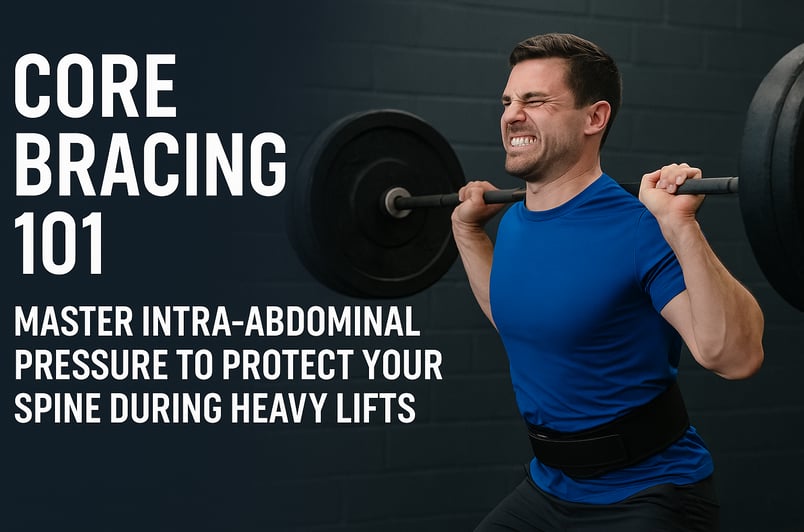Core Bracing 101: Master Intra-Abdominal Pressure to Protect Your Spine During Heavy Lifts
Learn how to protect your spine and lift safer with proper core bracing. This guide breaks down intra-abdominal pressure, real-life cues, and gear that supports safer, stronger lifts. Essential for lifters, athletes, and anyone serious about form.
5/25/20254 min read


Core Bracing 101: The Secret to Protecting Your Spine During Lifts
When it comes to lifting—whether you're squatting heavy, deadlifting, or pressing overhead—protecting your spine is non-negotiable. That's where core bracing comes in: it’s the secret weapon that stabilizes your torso, channels power, and helps prevent injuries. Let’s dive into why it matters, how it works, and how to cue it effectively.
What Is Core Bracing?
Core bracing isn't just about tucking your pelvis or squeezing your abs. It’s about creating a strong support system around your spine by engaging multiple muscles—deep abdominals, obliques, diaphragm, and pelvic floor—in unison. That tight cylinder of tension resists external forces, helping you keep your spine neutral under load.
The Power of Intra-Abdominal Pressure (IAP)
A cornerstone of core bracing is intra-abdominal pressure (IAP). Think of it like inflating a balloon inside your abdomen. When the diaphragm and pelvic floor push against a firm midsection, pressure builds, creating a rigid core. This internal support reduces spinal loading and improves lift efficiency.
Cue: “Balloon belly” – Breathe deep into your stomach (not your chest), feel your belly expand in all directions—front, sides, back. Hold that fullness during the lift.
Cue: “Brace like someone’s about to punch you” – Tighten your midsection as if protecting your gut from a light jab. Don’t suck in—push outward and tighten hard.
Cue: “Screw your feet into the floor” – Plant your feet and feel tension through your legs, engaging your diaphragm and pelvic floor as a result. Stability from the ground up enhances IAP.
How to Brace: Step by Step
Stand tall – Feet under hips (or shoulder-width), toes pointing slightly out.
Inhale deeply – Expand your belly like a balloon for 2–3 seconds.
Engage muscles – Tighten abs and obliques outward, brace like a punch.
Hold the pressure – Maintain this tension through your set. Breathe shallowly if needed.
Exhale gently at the top – After the lift, control your breath out, but keep some tension.
The goal is sustained pressure, not breath-holding. Controlled breathing maintains core rigidity while allowing you to reset for reps. A well-braced spine means safer, stronger lifts.
Product we recommend: IBRO Powerlifting Lever Belt
Looking for gear that reinforces your bracing technique? The IBRO Powerlifting Lever Belt (10mm) features a robust lever buckle that locks your belt securely and boosts IAP dramatically. Users praise its durability and stability:
"You can feel safe and confident that you’re protected... Quality of belt is great" Amazon
This belt locks evenly tight, giving you that external cue to brace the core and maintain internal pressure. It's ideal for squats, deadlifts, and heavy compound lifts.
Why External belts Matter
A solid lifting belt offers a tactile “stop” when you brace, reminding you to push your abs outward and lock in IAP. Think of it as feedback: if you don't feel the belt pushing against you, your brace isn't tight enough. Simply tightening the belt around your waist amplifies the internal balloon effect.
Product we recommend: E26 Self‑Locking Weight Lifting Belt
For functional athletes or those who lift frequently, the E26 Self-Locking Belt is built for performance and speed. A premium nylon belt with a metal buckle, it eliminates padding and mesh to ensure even pressure distribution:
"BUILT FOR PERFORMANCE: …designed with only one purpose in mind… ultimate performance for functional fitness athletes." Amazon
Its quick-locking mechanism lets you tighten mid-set without compromising form—perfect for WOD-style workouts where IAP must be maintained between explosive movements.
Real-Life Integration: Bracing in Everyday Lifts
Squat: Set your stance, inhale into your belly between reps, brace, squat, and maintain tension on the ascent.
Deadlift: Before lifting, take a deep breath, brace, and hold—this tight core supports the spine as you hinge and rise.
Overhead Press: Brace firmly before initiating the press overhead, and keep tension through the midline to prevent excessive lumbar extension.
Clean and Snatch: Pull under weight with a rigid core; bracing mid-snatch keeps your torso stable as you receive the barbell.
Product we recommend: Core Products Corfit LS Lumbar Support Belt
For those seeking both support and comfort, the Core Products Corfit LS Lumbar Support Belt increases IAP while offering lumbar compression and spinal alignment. It’s designed to stabilize your core and relieve lower back strain.
Highlights include:
Adjustable elastic straps for customized compression
Helps maintain posture and stabilize spine by enhancing intra-abdominal pressure Amazon
This belt is ideal for users focused on spinal health—especially if you spend long hours standing, sitting, or lifting.
Beyond Belts: Everyday Bracing Tips
Bodyweight practice – Even without weights, practice deep belly breaths and bracing. Lay on your back, inhale into your belly, brace, and hold for 10 seconds. Repeat.
Band drills – Wrap a resistance band around your torso at the belly level. Inhale and brace outward against the band’s resistance.
Mirror check – Breathe, brace, and check your torso angle in the mirror. Your spine should stay neutral—no rounding or excessive arching.
Progressive layering – Start beltless to learn cues. Once comfortable bracing naturally, introduce a belt to reinforce pressure and form.
The Bottom Line
Core bracing is not optional—it's foundational. By mastering intra-abdominal pressure through breathing, bracing cues, and consistent practice, you’ll protect your spine, optimize lifts, and build long-term habit. Equipment like IBRO or E26 belts and supportive lumbar designs can amplify what your core starts, reinforcing tension and maintaining form under load.
Protect your spine, grow stronger, train smarter—this is Core Bracing 101.
FITNESS
Nutrition
WellnesS
info@movebetterco.com
© 2025. All rights reserved | Privacy Policy | Terms & Conditions